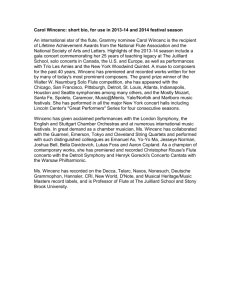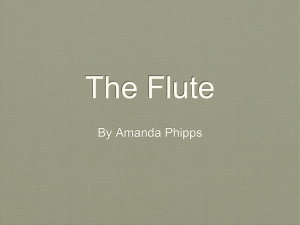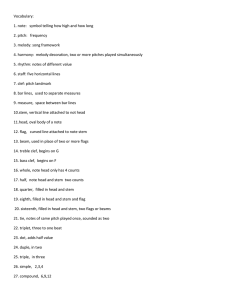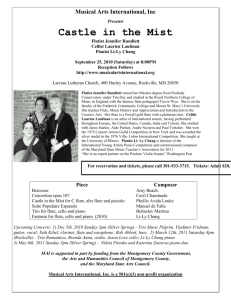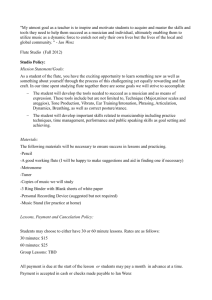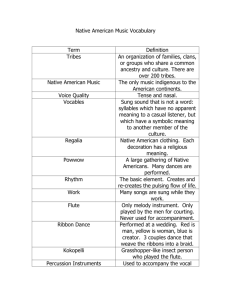Euterpea - Computer Science
advertisement
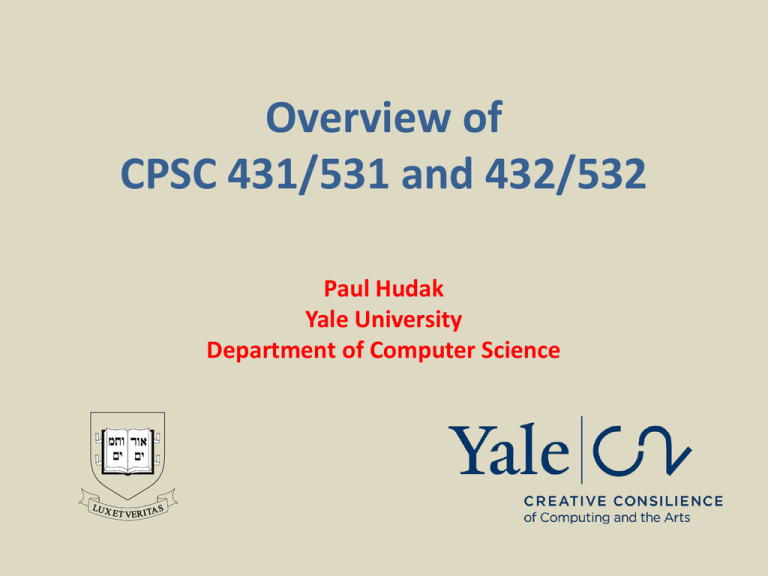
Overview of CPSC 431/531 and 432/532 Paul Hudak Yale University Department of Computer Science • The goal is not to teach technology; it is to teach the mathematics, engineering, and computer science that underlie the technology. • Undergraduate degrees: – BS major in Computing and the Arts – Specialized tracks in Art, Art History, Music, Theater Studies, and (coming soon) Architecture • Graduate degrees: – MS Degree in Computing and the Arts – PhD Degree in CS with focus on Computing and the Arts • Laboratories for graphics and music (the Euterpea Studio) My goal: Figuring out how PL research can enhance all this Haskell • A non-strict (“lazy”), purely functional, general purpose, programming language. • Designed in 1990. • Noted for its advanced type system, purity, lazy evaluation, and computational abstractions (functors, monads, arrows, and other variants). • Has influenced many other language designs (e.g. Python, C#, LINQ, Java, Scala, Clean, Mercury, Curry, Cayenne, Isabelle) • Excellent compiler and a thriving user community. • Some consider it “cool” to learn Haskell Euterpea “Euterpea” is derived from “Euterpe”, who was one of the nine Greek muses, or goddesses of the arts, specifically the muse of music. Euterpea: Computer Music in Haskell Why do this? After all, there are already several other languages for computer music… Motivation: • Special-purpose computer music languages are too narrow. • The conviction that Euterpea could be the best computer music programming environment. • The use of modern, state-of-the-art PL ideas in a fun area. • To combine my research with my hobby. • To use music to teach (functional) programming. • To give artists some powerful tools to enhance creativity. Can we change the way artists think? • Three ways that FP can help artists: – Abstraction – Abstraction – Abstraction • Examples from the Haskell world: – The usual: higher-order functions, lazy evaluation, etc. – The unusual: higher-order types, monads, arrows, and other computational abstractions. • “Monads for Artists”? (yeah right…) Euterpea by Example • Examples that demonstrate: – The basic ideas underlying Euterpea – Some of its unique design features – How Euterpea might help creative musicians – How learning computer music is a good way to learn computer programming (and vice versa) A Simple Example • First two bars expressed in Euterpea: (c 4 qn :+: d 4 qn :+: e 4 qn :+: f 4 qn :+: g 4 qn :+: f 4 qn :+: e 4 qn :+: d 4 qn) :=: (e 4 qn :+: f 4 qn :+: g 4 qn :+: a 4 qn :+: b 4 qn :+: a 4 qn :+: g 4 qn :+: f 4 qn) • Tedious, but accurate. • Can we do better? • Yes, using various forms of abstraction. Abstraction 101 (c 4 qn :+: d 4 qn :+: e 4 qn :+: f 4 qn :+: g 4 qn :+: f 4 qn :+: e 4 qn :+: d 4 qn) (e 4 qn :+: f 4 qn :+: g 4 qn :+: a 4 qn :+: b 4 qn :+: a 4 qn :+: g 4 qn :+: f 4 qn) :=: • Using data abstraction: line [c 4 qn, d 4 qn, e 4 qn, f 4 qn, g 4 qn, f 4 qn, e 4 qn, d 4 qn] :=: line [e 4 qn, f 4 qn, g 4 qn, a 4 qn, b 4 qn, a 4 qn, g 4 qn, f 4 qn] • Using higher-order functional abstraction: line (map fn [c, d, e, f, g, f, e, d] :=: line (map fn [e, f, g, a, b, a, g, f] where fn pc = pc 4 qn • Using function composition: gn [c, d, e, f, g, f, e, d] :=: gn [e, f, g, a, b, a, g, f] where gn = line . map fn; fn pc = pc 4 qn Haskell Equivalence • Q: How can we justify these simplifications? • A: Using proof by calculation. • Requires only three axioms: – line [m1, m2, …, mn] = m1 :+: m2 :+: … :+: mn – map fn [x1, x2, …, xn] = [fn x1, fn x2, …, fn xn] – (f . g) x = f (g x) • Complete novices can grasp this easily – no more difficult than high-school algebra. • (We also “reveal” the definitions of line and map, along with inductive proofs of the above “axioms.”) Simple Example Revisited • Here’s another way to write the example (polyphonic interpretation, rather than contrapuntal): (c 4 qn :=: e 4 qn) :+: (d 4 qn :=: f 4 qn) :+: (e 4 qn :=: g 4 qn) :+: (f 4 qn :=: a 4 qn) :+: (g 4 qn :=: b 4 qn) :+: (f 4 qn :=: a 4 qn) :+: (e 4 qn :=:g 4 qn) :+: (d 4 qn :=: f 4 qn) • It can likewise be simplified, in two steps: line [c 4 qn :=: e 4 qn, d 4 qn :=: f 4 qn, e 4 qn :=: g 4 qn, f 4 qn :=: a 4 qn, g 4 qn :=: b 4 qn, f 4 qn :=: a 4 qn, e 4 qn :=:g 4 qn, d 4 qn :=: f 4 qn] line (map fn [(c,e), (d,f), (e,g), (f,a), (g,b), (f,a), (e,g), (d,f)]) where fn (n1,n2) = n1 4 qn :=: n2 4 qn Euterpean Equivalence • But in what sense are the contrapuntal and polyphonic versions equivalent? • Note: they are not equivalent as Haskell values. • But they sound the same when “played”. • Thus we need a notion of interpretation, or performance. • Define a performance to be a sequence of events. • The event Event t p d captures the fact that at time t the pitch p plays for a duration d. Performance • The function perform does the desired interpretation: perform :: Music → Performance • Definition: Two music values m1 and m2 are equivalent, written m1 ≡ m2, if and only if: perform m1 = perform m2 • In other words: “if two things sound the same, they are the same” • For example: For all m1, m2, and m3: (m1 :+: m2) :+: m3 ≡ m1 :+: (m2 :+: m3) An Algebra of Music • There are eight axioms that comprise an algebra of music. • For example, (:=:) is associative and commutative. • Another (important) example: Duality of (:+:) and (:=:) For any m0, m1, m2, and m3 such that dur m0 = dur m2: (m0 :+: m1) :=: (m2 :+: m3) ≡ (m0 :=: m2) :+: (m1 :=: m3) • Each axiom is provably sound. • The axiom set is also complete: If two music values are equivalent, they can be proven so using only the eight axioms. • Furthermore, the algebra can be made polymorphic: it is valid for video, audio, animation, even dance. • The Eight Laws of Polymorphic Temporal Media. Puttin’ the “funk” back in functional programming. Funkmaster Paul In da house at Yale University Available now at your neighborhood cafepress.com… Self-Similar Music • Begin with a simple melody of n notes. • Now duplicate that melody n times, playing each in succession, but first perform these transformations: – transpose the ith melody proportionally to the pitch of the ith note in the original melody, and – scale its tempo proportionally to the duration of the ith note. • Apply this process infinitely often, yielding an infinitely dense melody of infinitesimally shorter notes. • To make the result playable, stop the process at some predetermined level. Example of Self-Similar Music … … … … … Self-Similar Music in Euterpea • We could write an inductive mathematical definition of the tree. • But we might as well use Euterpea instead: data Cluster = Node SNote [Cluster] type SNote = (Dur, AbsPitch) -- a Rose Tree selfSim :: [SNote] -> Cluster selfSim pat = Node (0,0) [mkClust p | p <- pat] where mkClust note = Node note [mkClust (addMul note p) | p <- pat] addMul (d0,p0) (d1,p1) = (d0*d1, p0+p1) fringe :: Int -> Cluster -> [SNote ] fringe 0 (Cluster note cls) = [note ] fringe n (Cluster note cls) = concatMap (fringe (n-1)) cls Example • Use this 4-note motif as the seed: • Traverse 4 levels in the tree. • Play together with itself in reverse and transposed down one octave: m :=: transpose (-12) (revM m) Other Approaches to Self-Similarity • Fractals • Context-free grammars • L-Systems • All easily expressed in Euterpea (and discussed in my book) Musical User Interface (MUI) • Design philosophy: – GUI’s are important! – The dataflow metaphor (“wiring together components”) is powerful! – Yet graphical programming is inefficient… • Goal: MUI widgets using dataflow model at the linguistic level. • We achieve this via two levels of abstraction: – The UI Level • Create widgets, attach titles, labels, etc. • Control layout – The Signal Level • A signal is conceptually a continuous (time-varying) value. • Sliders, knobs, etc. are input widgets. • Midi out, graphics, etc. are output widgets. Signals • Signals are time-varying quantities. • Conceptually they can be thought of as functions of time: Signal a = Time → a • For example, output of a slider is a time-varying number. • Key idea: Lift all static functions to the signal level using a family of lifting functions: lift0 :: a → Signal a lift1 :: (a → b) → (Signal a → Signal b) lift2 :: (a → b → c) → (Signal a → Signal b → Signal c) • Haskell’s type classes make this especially easy. • Conceptually: s1 + s2 sin s = = λt → s1 t + s2 t λt → sin (s t) • One can also integrate signals. Events • Signals are not enough… some things happen discretely. • Events can be realized as a kind of signal: data Maybe a = Nothing | Just a type EventS a = Signal (Maybe a) • So events are actually event streams. • Midi event streams simply have type: EventS [MidiMessage] where MidiMessage encodes standard Midi messages such as Note-On, Note-Off, etc. MUI Examples • Pitch translator: do ap ← title "Absolute Pitch" (hiSlider 1 (0, 100) 0) title "Pitch" (display (lift1 (show ◦ pitch) ap) ) • Output Midi note at constant rate: do ap ← title "Absolute Pitch" (hiSlider 1 (0, 100) 0) f ← title "Tempo" (hSlider (1, 10) 1) t ← time let ticks = timer t (1/f) let ns = snapshot ticks ap =>> (λk → [ANote 0 k 100 0.1]) midiOut 0 ns Bifurcate Me, Baby! • Consider the recurrence equation: xn+1 = r * xn * (1 - xn) Start with an initial population x0 and iteratively apply the growth function to it, where r is the growth rate. For certain values of r, the population stabilizes, but as r increases, the period doubles, quadruples, and eventually leads to chaos. It is one of the classic examples in chaos theory. • In Euterpea: grow r x = r * x * (1-x) Then wrap it up in a MUI bifurcate = runMUI (300,500) "Bifurcate!" (do t ← time f ← title "Frequency" (withDisplay (hSlider (1, 10) 1)) r ← title "Growth rate" (withDisplay (hSlider (2.4, 4.0) 2.4)) let ticks = timer t (1.0 / f) pop = accum 0.1 (snapshot ticks (lift1 grow r)) title "Population" (display' pop) midiOut 0 (snapshot ticks pop =>> popToNote) popToNote x = [ANote 0 n 64 0.05] where n = truncate (x*127) Bifurcate Me, Baby! Gary Lee Nelson 1995 Taking the Signal Metaphor a Step Further • Sound synthesis and audio processing – “vertical” language design – “from signals to symphonies” • Key idea: a signal function • The type SF Clk In Out is the type of signal function that maps signals of type In to signals of type Out, at abstract clock rate Clk. Key Idea • This signal processing diagram: y sigfun x • is equivalent to this Euterpean code, using “arrow” syntax: y <- sigfun -< x Physical Model of a Flute lineSeg sinA 5 lineSeg envibr env1 * 0.1 rand 1 × flow vibr + * breath emb + Embouchure delay sum1 delayt (1/fqc/2) x x – x3 + lowpass out * amp × returnA env2 * feedbk2 * feedbk1 Flute bore delay flute delayt (1/fqc) bore lineSeg Flute Model in Euterpea flute dur freq amp vfreq = in proc () -> do amp1 <- linseg … -< () amp2 <- linseg … -< () ampv <- linseg … -< () flow <- rand 1 -< amp1 vibr <- oscils vfreq -< 0.1 * ampv rec let feedbk = body * 0.4 body <- delay (1/freq) -< out x <- delay (1/freq/2) -< breath*flow + amp1 + vibr + feedbk out <- tone -< (x - x*x*x + feedbk, 2000) returnA -< out*amp*amp2 Flute Demo • f0 and f1 demonstrate the change in the breath parameter. f0 = flute 3 0.35 440 0.93 0.02 f1 = flute 3 0.35 440 0.83 0.05 • f2 has a weak pressure input so only plays the blowing noise. f2 = flute 3 0.35 440 0.53 0.04 • f3 takes in a gradually increasing pressure signal. f3 = flute 4 0.35 440 (lineSeg [0.53, 0.93, 0.93] [2, 2]) 0.03 • Sequence of notes: Programming Language Concepts That You Will Learn • • • • Higher-Order Functions Lazy Evaluation Proof By Calculation Types – – – – Polymorphic types Qualified types Type Classes Higher-Order Types • Computational Abstractions – Functors – Monads – Arrows Computer Music Concepts That You Will Learn • • • • • • • • • Note-level Representations of Music Interpretation and Performance Signal-level Representations of Sound Spectrum Analysis Additive and Subtractive Synthesis Amplitude and Frequency Modulation Physical Modeling (waveguides, non-linear models) Filters Effects (panning, reverb, flanging, etc.) The Sky is the Limit • In Music: – Can we create a robotic conductor? – What does a saxophone the size of a house sound like? Or a clariphone or saxonet? – Can we animate a new choreography? – Can we create new forms of artistic expression? – Can the mathematics of music lead to new forms of algorithmic composition? – Can a computer compose music that passes the Turing Test? (David Cope, a guest lecturer last year, would say “yes.”) • In Computer Science: – – – – Can we do all this in real time? Interactively? Can we parallelize computer music computation? What is the essence of “functional reactive programming”? How do we combine all this with animation? “Bottles” • Composed and implemented by Donya Quick, a grad student in CS • Done entirely in Euterpea • Demonstrates: – High-level composition • Notes, repetitions, structure • Micro-tonal support – Low-level signal processing • Both “struck” bottle and “blown” bottle sounds, using physical modeling • Some additive synthesis as well • Reverb and audio processing
